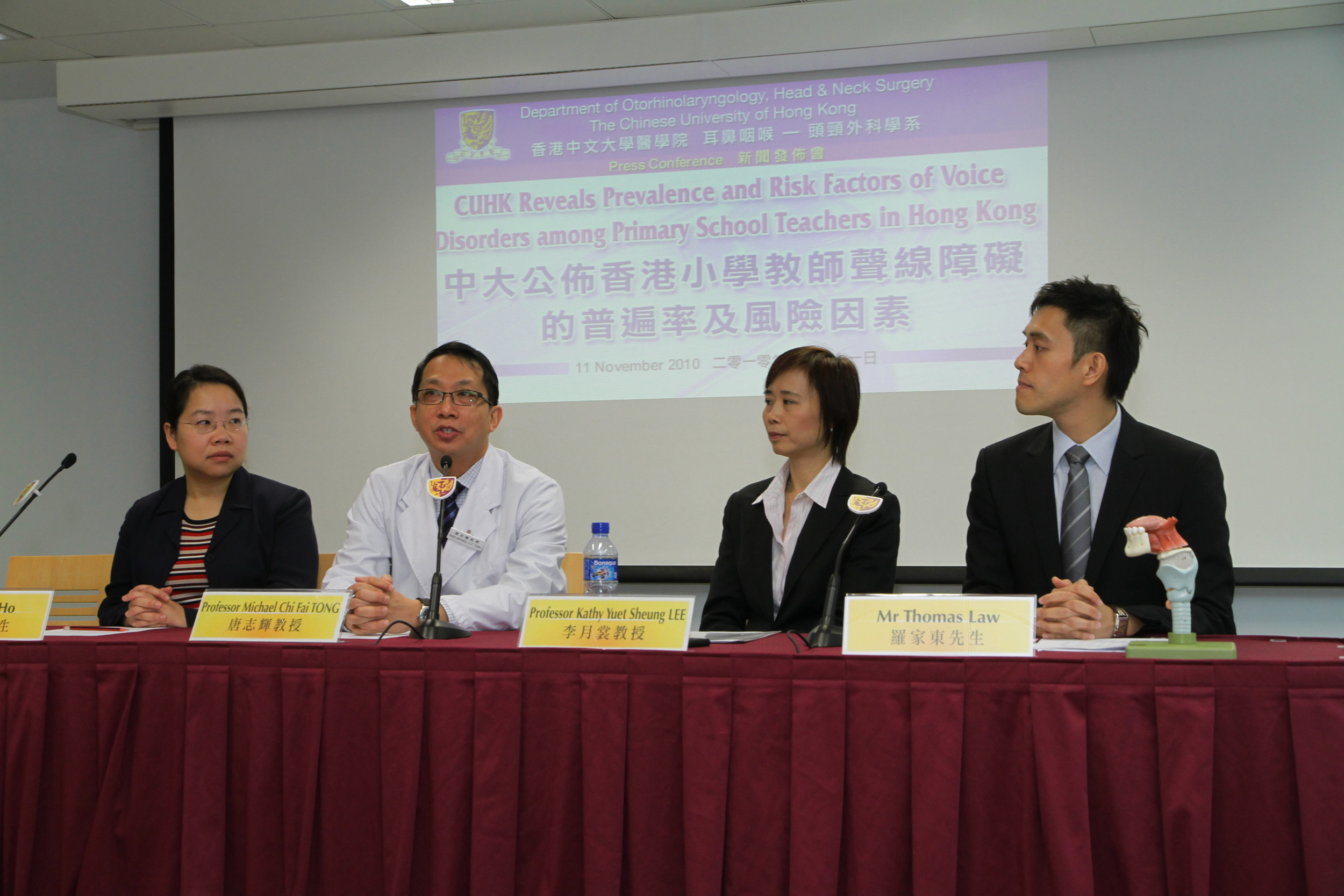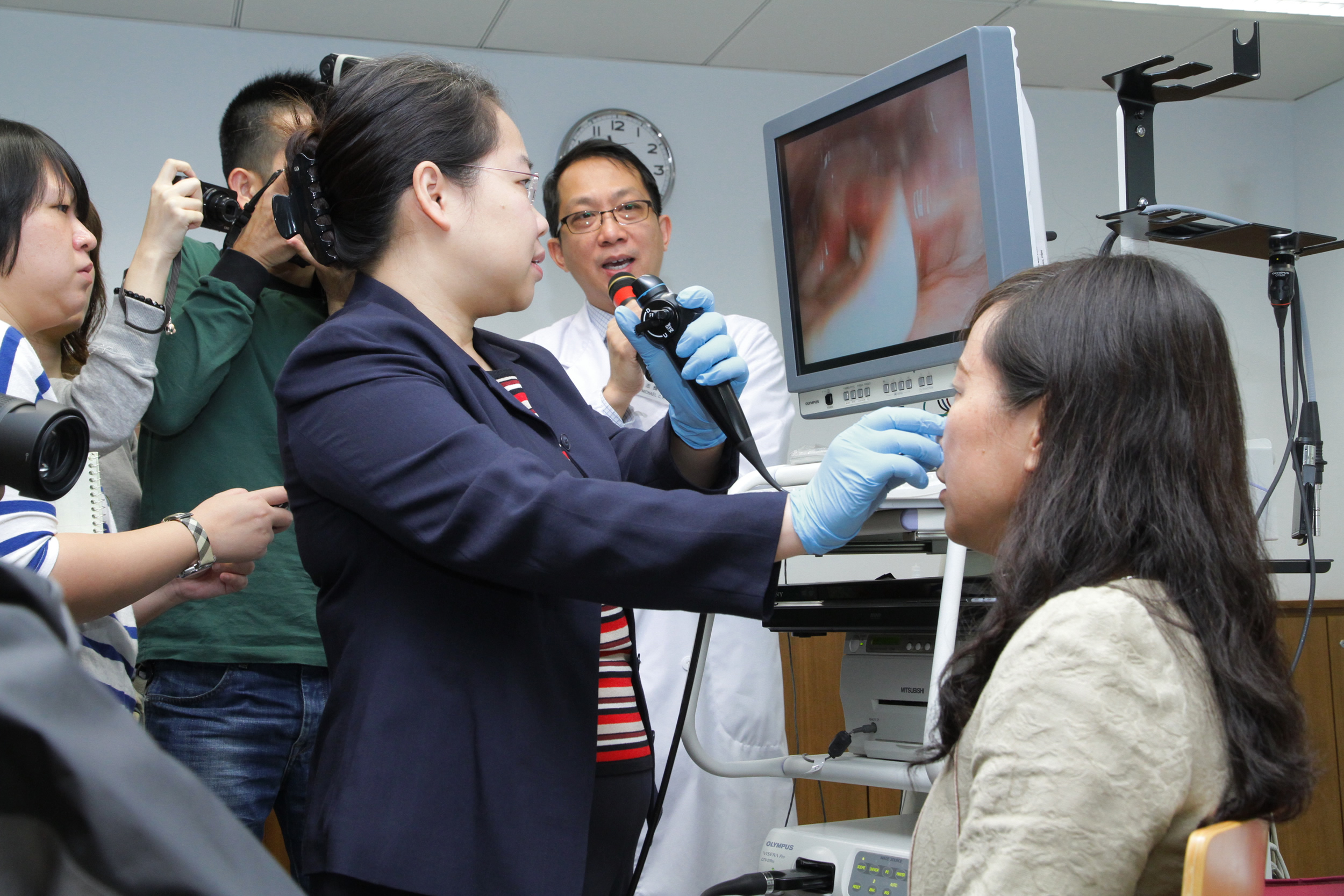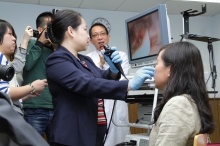CUHK
News Centre
CUHK Faculty of Medicine Reveals Prevalence and Risk Factors of Voice Disorders among Primary School Teachers in Hong Kong
A studyconducted by the Department of Otorhinolaryngology, Head and Neck Surgery at The Chinese University of Hong Kong (CUHK) has shown that 42.3% of primary school teachers have some degree of voice disorder. According to the recent census data, there are 22,219 primary school teachers in Hong Kong. Based on this estimation, 9,398 of them suffer from voice disorders.
Voice disorder is the major occupational hazard for school teachers. It adversely affects their daily functioning and work abilities. The presence of voice disorders has not only hampered teachers’ social interaction, self-esteem, communication effectiveness and their quality of life, but also bears profound economic impact on society. In the US, losses due to voice disorders in teachers are estimated to run to about US$2 billion annually. The costs entail voice therapy, surgery, sick leave, substitute teachers and pharmaceutical treatment.
With direct grant from the University, the Department of Otorhinolaryngology, Head and Neck Surgery at CUHK conducted a cross-sectional study in 2008 and 2009 to investigate the prevalence and associated risk factors of voice disorders in primary school teachers. In contrast with previous studies that identify teachers with voice disorders by only using questionnaires, this is the first study in Hong Kong where all interviewed teachers are assessed directly and individually by both otorhinolaryngologist and speech therapist. Hence, the results of the study can be considered more objective and holistic.
Using multi-stage sampling, a school was randomly selected from each of the 18 geographic districts in Hong Kong. A total of 359 teachers, including 289 females (80.5%) and 70 males (19.5%), participated in the study. All of the teachers received a laryngeal assessment by an otorhinolaryngologist to determine the presence of laryngeal pathology, as well as a perceptual evaluation of voice by two speech therapists to assess voice quality.
The study found that the prevalence of voice disorders among primary school teachers in Hong Kong is 42.3%, with 87.5% being female and 22.5% being male. The prevalence of teachers with vocal pathology and hyperfunctional voice disorder is 17.5% and 24.8% respectively.
Statistical analysis revealed four factors are associated with voice disorders. These being sex of the teachers, the frequency with which they are required to sing at work, average number of students in the class, and whether the lesson is longer than 35 minutes. The study showed that female teachers face higher odds of developing voice disorders (2.25) than their male counterparts. Teachers who have to sing frequently have a lower chance (0.43 odds) of voice disorder than those who are not required to sing as frequently. The class size also contributes to whether teachers will experience voice disorders. The study indicated that for every additional student in the classroom, the teacher will risk 1.06 higher odds of voice disorder. Using this figure as a basis for calculation, the odds of a teacher suffering voice disorder in a class with an addition of five students will increase to 1.34, and will rise to 1.8 in a class with 10 more students. Furthermore, teachers conducting lessons that are longer than 35 minutes face higher odds of voice disorders (1.77) when compared to teachers with lessons shorter than 35 minutes.
The CUHK study also showed that, regardless of the presence of voice disorders, teachers experience a range of vocal symptoms, with the most common ones being dryness of the throat (46%), vocal fatigue (41.5%) and the sensation of a lump in the throat (40%). With an average of two vocal symptoms, teachers with voice disorders experience more vocal symptoms than those without. The vocal symptoms significantly associated with voice disorders include pain in the throat, hoarseness, and loss of voice. With regard to quality of life, teachers with voice disorders score significantly lower than those without voice disorders.
Despite the high prevalence of voice disorders among primary school teachers, only 44.7% seek medical advice for their condition. Among those who seek medical advice, 48.7% consult a general practitioner, 35.7% consult an otorhinolaryngologist, 13.5% seek advice from a Chinese medicine practitioner, and 7.7% consult a speech therapist.
Of the teachers who participated in the study, 31.2% reported taking days off work due to their voice problems. The days off over the past 12 months ranged from one day to a year, with an average of two days. Of those who took days off work, 45.5% were diagnosed with voice disorders while 54.5% were not at the time of the study. These figures exposed the fact that teachers without voice disorders also experience vocal difficulties that affect their work. Even though this group of teachers has not been diagnosed with voice disorders, they could be regarded as a group at risk, requiring follow-up to prevent the development of voice disorders in future.
Considering the high prevalence of voice disorders among primary school teachers in Hong Kong and its implication for the education system, various programmes should be implemented to provide intervention and prevention services. This may include voice intervention programmes for teachers with voice disorders, healthy voice use workshops for current and future teachers to prevent the development of voice disorders, and accessible voice assessment services to monitor vocal status of teachers. It is also recommended that teachers who experience pain in the throat, hoarseness and loss of voice after teaching should seek professional advice to rule out possible voice disorder.
Enquiries: Division of Speech Therapy, Department of Otorhinolaryngology, Head and Neck Surgery, CUHK (Tel: 2144-5360)
CUHK Faculty of Medicine Reveals Prevalence and Risk Factors of Voice Disorders among Primary School Teachers in Hong Kong





